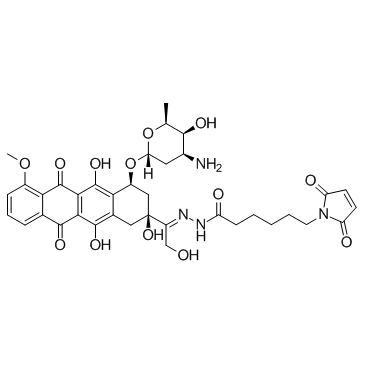1361644-26-9
| Name | N-[(E)-[1-[(2S,4S)-4-[(2R,4S,5S,6S)-4-amino-5-hydroxy-6-methyloxan-2-yl]oxy-2,5,12-trihydroxy-7-methoxy-6,11-dioxo-3,4-dihydro-1H-tetracen-2-yl]-2-hydroxyethylidene]amino]-6-(2,5-dioxopyrrol-1-yl)hexanamide |
|---|---|
| Synonyms |
DOXO-EMCH
1H-Pyrrole-1-hexanoic acid, 2,5-dihydro-2,5-dioxo-, 2-[(1E)-1-[(2S,4S)-4-[(3-amino-2,3,6-trideoxy-α-L-lyxo-hexopyranosyl)oxy]-1,2,3,4,6,11-hexahydro-2,5,12-trihydroxy-7-methoxy-6,11-dioxo-2-naphth acenyl]-2-hydroxyethylidene]hydrazide INNO-206 N'-[(1E)-1-{(2S,4S)-4-[(3-Amino-2,3,6-trideoxy-α-L-lyxo-hexopyranosyl)oxy]-2,5,12-trihydroxy-7-methoxy-6,11-dioxo-1,2,3,4,6,11-hexahydro-2-tetracenyl}-2-hydroxyethylidene]-6-(2,5-dioxo-2,5-dihydro -1H-pyrrol-1-yl)hexanehydrazide Aldoxorubicin (USAN) Aldoxorubicin CS-1186 |
| Description | Aldoxorubicin (INNO-206) is an albumin-binding prodrug of doxorubicin, which is released from albumin under acidic conditions. Aldoxorubicin (INNO-206) has potent antitumor activities in various cancer cell lines and in in murine tumor models. |
|---|---|
| Related Catalog | |
| Target |
Topoisomerase II |
| In Vitro | Aldoxorubicin (INNO-206) (0.27 to 2.16 μM) inhibits blood vessel formation and reduces multiple myeloma cell growth in a pH-dependent fashion[1]. |
| In Vivo | Aldoxorubicin (INNO-206) (10.8 mg/kg, i.v.) shows significantly smaller tumor volumes and IgG levels on days 28, and is well tolerated with 90% of mice surviving until the termination of the study in the mice bearing the LAGκ-1A tumor[1]. Aldoxorubicin (INNO-206) shows a good safety profile at doses up to 260 mg/mL doxorubicin equivalents, and is able to induce tumor regressions in breast cancer, small cell lung cancer and sarcoma in phase I study[2]. Aldoxorubicin (INNO-206) shows superior activity over doxorubicin in a murine renal cell carcinoma model and in breast carcinoma xenograft models[3]. |
| Cell Assay | Cells are seeded at 1×105 cells/100 μL/well in 96-well plates in RPMI-1640 media with FBS for 24 hours before treatment. Cells are cultured in the presence of medium, Aldoxorubicin (INNO-206) or doxorubicin for 48 hours. Next, cell viability is quantified using the CellTiter 96 AQueous Non-Radioactive Cell Proliferation Assay. Each well is treated with MTS for 1 to 4 hours, after which absorbance at 490 nm is recorded using a 96-well plate reader. The quantity of formazan product as measured is directly proportional to the number of living cells. Data graphed are means±SEM using 3 replicates per data point. |
| Animal Admin | For the LAGκ-1A experiment, Aldoxorubicin (INNO-206) is administered to SCID mice at 10.8 mg/kg (doxorubicin equivalent dose of 8.0 mg/kg) once weekly. Mice are treated with conventional doxorubicin at 4.0 and 8.0 mg/kg once weekly. For the LAGκ-2 experiment, Aldoxorubicin (INNO-206) is administered once weekly (W) at doses of 2.7 and 5.4 mg/kg, or on 3 consecutive days (W-F) weekly at doses of 0.9 and 1.8 mg/kg. Bortezomib is administered twice weekly (W, F) at a dose of 0.5 mg/kg. Doxorubicin is administered to SCID mice at 2, 4, and 8 mg/kg, and PLD is administered to SCID mice at 2 mg/kg once weekly. Each drug is administered i.v. in a volume of 100 μL. |
| References |
| Density | 1.6±0.1 g/cm3 |
|---|---|
| Molecular Formula | C37H42N4O13 |
| Molecular Weight | 750.748 |
| Exact Mass | 750.274841 |
| PSA | 271.33000 |
| LogP | 3.08 |
| Index of Refraction | 1.708 |
| Storage condition | 2-8℃ |
